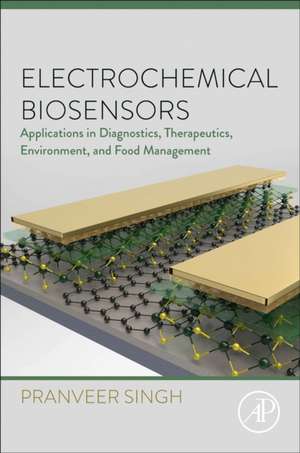Electrochemical Biosensors: Applications in Diagnostics, Therapeutics, Environment, and Food Management
Autor Pranveer Singhen Limba Engleză Paperback – 18 noi 2021
- Takes account of the fact that nanomaterials are increasingly favored as labels for electrochemical immunoassay protocols for the development of highly sensitive and selective electrochemical sensing device
- Refines biosensors for real-world settings, academicians, healthcare professionals and industrialist who need to team up for the successful realization of POCT/LOCT devices
- Contains focused and targeted research coupled with other technological advances to help in the development of cutting-edge nanomaterial based electrochemical immunoassays with features of test-strip technology and lateral flow
Preț: 735.42 lei
Preț vechi: 808.15 lei
-9% Nou
Puncte Express: 1103
Preț estimativ în valută:
140.72€ • 147.30$ • 117.13£
140.72€ • 147.30$ • 117.13£
Carte tipărită la comandă
Livrare economică 24 martie-07 aprilie
Preluare comenzi: 021 569.72.76
Specificații
ISBN-13: 9780323906326
ISBN-10: 032390632X
Pagini: 210
Ilustrații: 50 illustrations (25 in full color)
Dimensiuni: 152 x 229 mm
Editura: ELSEVIER SCIENCE
ISBN-10: 032390632X
Pagini: 210
Ilustrații: 50 illustrations (25 in full color)
Dimensiuni: 152 x 229 mm
Editura: ELSEVIER SCIENCE
Cuprins
1. Introduction
2. Types of Electrochemical Immunosensors based on electric signals
3. Types of Electrochemical Immunosensors Based on different Nanomaterials
4. Nanomaterial-based enzyme electrodes for food quality assessment
5. Electrochemical immunosensing for the assessment of circulating biomarkers
6. Microfluidic Devices assisted cancer biomarkers detection
7. Nucleic acid based Electrochemical Genosensing of Circulating Biomarkers
8. Electrochemical sensing of breast cancer biomarkers
9. Electrochemical biosensing of gene-specific mutations and miRNAs associated with breast cancer in biofluids
10. Electrochemical Aptasensors for breast cancer protein circulating biomarkers
11. Electrochemical immunosensing of circulating protein biomarkers
12. Electrochemical peptide-biosensor for the detection of circulating breast cancer protein biomarkers
13. Electrochemical biosensing for multiple determination of circulating breast cancer biomarkers
14. Biomarkers for Cardiovascular disease
15. Diabetes
16. Genetic disorder
17. Viral disease biomarkers
18. Electrochemical genosensing of biomarkers for viral infections
19. Electrochemical genosensors for the neurodegenerative disease biomarkers
20. Electrochemical genosensors for bacterial infection biomarkers
21. Nanomaterial based electrochemical immunosensing of infectious pathogens in liquid biopsies
22. Infectious dose (Bacteria and viruses)
23. Conclusions
24. Future perspective
2. Types of Electrochemical Immunosensors based on electric signals
3. Types of Electrochemical Immunosensors Based on different Nanomaterials
4. Nanomaterial-based enzyme electrodes for food quality assessment
5. Electrochemical immunosensing for the assessment of circulating biomarkers
6. Microfluidic Devices assisted cancer biomarkers detection
7. Nucleic acid based Electrochemical Genosensing of Circulating Biomarkers
8. Electrochemical sensing of breast cancer biomarkers
9. Electrochemical biosensing of gene-specific mutations and miRNAs associated with breast cancer in biofluids
10. Electrochemical Aptasensors for breast cancer protein circulating biomarkers
11. Electrochemical immunosensing of circulating protein biomarkers
12. Electrochemical peptide-biosensor for the detection of circulating breast cancer protein biomarkers
13. Electrochemical biosensing for multiple determination of circulating breast cancer biomarkers
14. Biomarkers for Cardiovascular disease
15. Diabetes
16. Genetic disorder
17. Viral disease biomarkers
18. Electrochemical genosensing of biomarkers for viral infections
19. Electrochemical genosensors for the neurodegenerative disease biomarkers
20. Electrochemical genosensors for bacterial infection biomarkers
21. Nanomaterial based electrochemical immunosensing of infectious pathogens in liquid biopsies
22. Infectious dose (Bacteria and viruses)
23. Conclusions
24. Future perspective
